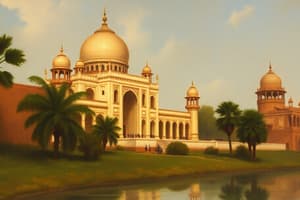Podcast
Questions and Answers
What was the source of water supply to the city of Thanjavur?
What was the source of water supply to the city of Thanjavur?
Water supply to the city of Thanjavur came from wells and tanks.
Who lived in the 'Black Towns' in cities like Madras during the eighteenth century?
Who lived in the 'Black Towns' in cities like Madras during the eighteenth century?
Native traders, craftspersons, merchants, and artisans like weavers lived in the 'Black Towns'.
Why did towns grow around temples in ancient India?
Why did towns grow around temples in ancient India?
Towns grew around temples because temples were central to the economy and society, attracting priests, workers, artisans, and traders.
What role did the craftspersons play in the building of temples?
What role did the craftspersons play in the building of temples?
What were the craftspersons of Bidar famous for?
What were the craftspersons of Bidar famous for?
Why did people from distant lands visit Surat?
Why did people from distant lands visit Surat?
What major changes occurred in craft production in cities like Calcutta?
What major changes occurred in craft production in cities like Calcutta?
How were craftspersons in Thanjavur different from those in Calcutta?
How were craftspersons in Thanjavur different from those in Calcutta?
What type of cloth did the Saliya weavers of Thanjavur produce?
What type of cloth did the Saliya weavers of Thanjavur produce?
Flashcards are hidden until you start studying
Study Notes
Water Supply in Thanjavur
- Water supply to the city of Thanjavur came from wells and tanks.
Merchants and Artisans in Cities
- During the 18th century, merchants and artisans (such as weavers) were moved into the 'Black Towns' established by European companies in cities like Bombay, Calcutta, and Madras.
- Native traders and craftspersons were confined to the 'Black Towns', while European rulers occupied superior residencies.
Temple Towns
- Towns grew around temples because temples were central to the economy and society.
- Rulers constructed temples to demonstrate their devotion to deities and endowed them with grants of land and money.
- A large number of priests, workers, artisans, traders, etc. settled near the temple to cater to its needs and those of the pilgrims, leading to the formation of temple towns.
- Examples of temple towns include Kanchipuram, Madurai, and Tirupati.
Craftspersons and Temple Building
- The Panchalas or Vishwakarma community (goldsmiths, bronzesmiths, blacksmiths, masons, and carpenters) played an essential role in the building of temples.
- Craftspersons of Bidar were famous for their copper and silver works, known as 'Bidri'.
- Weavers like the Saliyar or Kaikkolars emerged as prosperous communities, making donations to temples.
Surat as a Cosmopolitan City
- Surat was a cosmopolitan city with people of all castes and creeds living there.
- People from distant lands visited Surat for trade with West Asia via the Gulf of Ormuz, and for its famous textiles with gold lace borders (zari).
- The city had numerous rest houses, magnificent buildings, and pleasure parks to cater to the needs of visitors from all over the world.
Craft Production in Calcutta and Thanjavur
- Craft production in cities like Calcutta was organized by European companies, where craftspersons were not free to sell their own crafts and textiles.
- In contrast, craftspersons in Thanjavur were independent and free to sell their own products, living nearby the temples.
- The Saliya weavers of Thanjavur produced cloth for flags, fine cotton for the king and nobility, and coarse cotton for the masses.
Studying That Suits You
Use AI to generate personalized quizzes and flashcards to suit your learning preferences.




